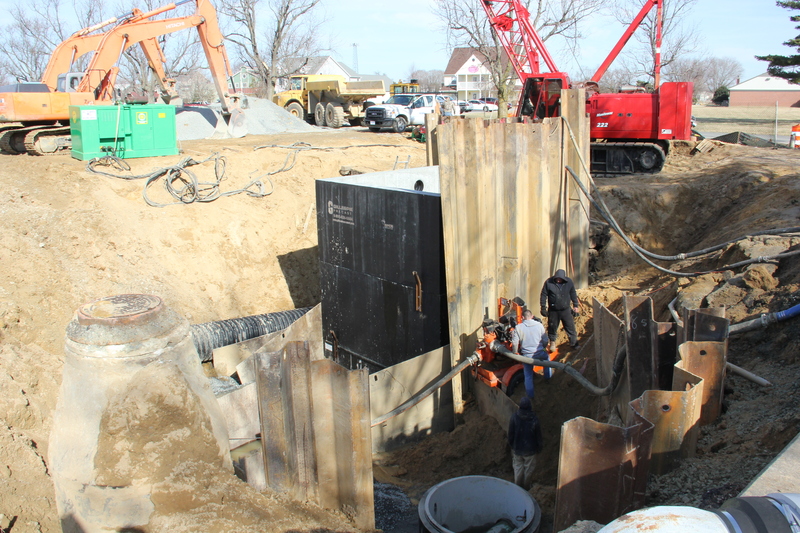A $3 million wastewater pumping station project at the corner of Nassau Commons Boulevard and Route 9 near the Vineyards at Nassau Valley offers more proof that the pace of development in the eastern part of Sussex County continues to clip along.
Sussex County engineer Mike Izzo said the pump station was part of the original West Rehoboth Expansion of the Dewey Beach Sanitary Sewer District in 1993. “We did another expansion in about 1999, and we knew then that we would have to expand again. The Lewes Crossing project is well underway across the street from the station, and the Vineyards project has hundreds more dwelling units slated over the next several years. Plus, this station will serve the new Coastal Club project out on Route 285 until the Goslee Creek regional pumping station goes on line in a few years.”
Wastewater pumping stations include deep holes lined with poured concrete wells. Depth is required since part of the system depends on the force of gravity to move wastewater, and there has to be a collection well at the end of the system. This is the reason why most of us on the county system don’t have to give it much more thought than whether the toilet is flushing properly. Since Sussex County is so flat, a lot of thought has to be given to designing systems that will have natural flow, which will be augmented with pumps when gravity is no longer an option.
The expanded pump station project includes installation of new force main pipes to Five Points and along the west side of Route 1. Those pipes will handle wastewater pumped from the expanded station to another pumping station on Wescoats Road across Route 1 from Delaware State Police Troop 7 and near the Exxon station and market. (This is one of those knee-bones-connected-to-the-thigh-bones situations.)
That Wescoats pumping station in turn sends the wastewater through underground pipes to the Wolfe Neck Regional Wastewater Facility at the end of Wolfe Neck Road. But because the Wolfe Neck spray irrigation facility has just about reached capacity, Izzo said, another large pump station expansion project at Wescoats Road will be bid this spring. When that project is complete, wastewater pumped from the Nassau station will be able to be directed either to the Wolfe Neck facility or to the much larger Inland Bays Regional Wastewater Facility west of Long Neck. The Inland Bays facility will also eventually be collecting wastewater from the Goslee Creek pump station that will be sending from communities in the area west of Plantation Road.
Lots of expansion available
The Inland Bays facility is situated on 2,400 acres of contiguous farmland. “We have lots of existing capacity there and room for future expansion,” said Izzo. “All that acreage gives us room to spread out our spraying areas.”
If the West Rehoboth expansion of the Dewey Beach Sanitary Sewer District is any indication, need for that extra space at the Inland Bays site is not a large stretch of the imagination. “Even when the economy was slow in Sussex after 2005 and 2006, we continued to have growth in connections going to the Wolfe Neck facility.” It serves the neighborhoods west of Rehoboth Beach, all along Route 1 to Five Points, and the communities of the greater Lewes community beyond. Izzo said the facility was originally permitted to handle up to 4 million gallons of wastewater per day. But when the public resisted the idea of using another 300 acres of Cape Henlopen State Park land along Wolfe Neck Road to supplement the existing 300 acres of spraying fields at the east end of Wolfe Neck, Izzo said the county had to redirect its thinking toward the Inland Bays facility. “Hydrologically, we feel we should limit that Wolfe Neck facility to no more than 1.8 to 2 million gallons of wastewater per day. Beyond that, it stresses the soils, and we want to be conservative. We think the facility will operate most efficiently at that rate. We’ve been running that facility since 1996 and have a good idea about how best to manage it.”
So, how much more capacity does the Wolfe Neck facility have? Not much, especially depending on the time of year. Izzo said summertime flows in 2014 reached the 2 million gallons per day rate. “We were able to manage, but we still think we should cap it at 1.8 million gallons. Fortunately, our highest flows come in June, July and August when the soils are the driest, the sun is shining and there’s plenty of evaporation.” There’s also more uptake by crops at that time of the year. In the winter months, when summer visitors and snowbirds head out, the flow drops off.
Izzo said the dual-directing pump station planned for the Wescoats Corner site will give the county system the flexibility it needs to deal with anticipated growth.
Congestion, apparently, isn’t only limited to the highway department.

















































